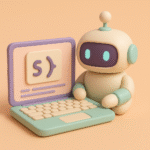
Why Tokens Matter in Your AI-Powered Web App (And How to Manage Them Like a Pro!)
The Problem You Didn’t Know You Had
Imagine you have a cup, and you’re slowly pouring water into it. At first, everything fits just fine. But as you keep pouring, the water reaches the top and starts to overflow.
Table Of Content
The cup can only hold so much.
So, what can you do?
- Stop pouring?
- Pour out some of the water to make room for new water?
- Use a bigger container, if possible?
Your AI app faces the same problem with tokens.
This relates to AI token management: just like a cup has a limit, AI models have token limits, and you need to manage how much you put in to keep things flowing smoothly.
If you don’t manage your tokens properly, your app gets expensive, slows down, or even stops working.
So, what are tokens? And why should you care? Let’s break it down.
What Are Tokens?
Think about your AI model like a laptop with limited storage.
You can only store so many files before you need to start deleting, compressing, or upgrading storage.
Tokens are how AI “stores” and “understands” text.
Instead of full sentences or words, AI breaks everything down into tokens—small pieces of text that it can process.
Let’s look at a simple sentence:
“Hello, how are you?”
- You see: 4 words
- AI sees it like this
["Hello", ",", " how", " are", " you", "?"]That’s 6 tokens, not 4 words!
Why? AI doesn’t just count words. It breaks them into parts, punctuation, and even spaces!
Here’s another example:
“Artificial Intelligence is amazing!”
- We see: 4 words
- AI sees tokens like this:
["Artificial", " Intelligence", " is", " amaz", "ing", "!"]Notice “amazing” got split into two tokens? AI doesn’t always treat words like we do.
Why Should You Care About Tokens?
Let’s say your AI model has a memory limit of 4,096 tokens.
Every message you send adds to that count. If you go over the limit, your AI forgets old messages, costs more, or crashes your app.
Here’s what can happen if you ignore token limits:
❌ Your AI forgets important context mid-conversation
❌ You hit API errors because the request is too long
❌ Your app becomes expensive because more tokens = more cost
❌ Slower responses (more tokens = more processing time)

Wouldn’t it be nice to control how AI manages its memory?
That’s where token management comes in.
How to Manage Tokens in Your AI App
Think of your chat history like your laptop storage. You don’t want to keep every single file forever, so you need to:
- Delete old conversations when needed
- Summarize older messages instead of throwing them away
- Limit unnecessary words to keep things concise
Here’s how we count and limit tokens in a Next.js AI app.
Step 1: Count Tokens in a Message
We can use OpenAI’s tiktoken library to accurately count tokens:
javascriptCopyEditimport { encoding_for_model } from "@dqbd/tiktoken";
// Initialize tokenizer for GPT-4
const enc = encoding_for_model("gpt-4");
const text = "Hello, how are you?";
const tokenCount = enc.encode(text).length;
console.log(`Token count: ${tokenCount}`); // Output: 6
💡 Try running this on different sentences! You’ll see how AI breaks them down.
Step 2: Limit Chat History to Avoid Crashes
Now, let’s trim old messages if they exceed a safe token limit.
javascriptCopyEditimport { encoding_for_model } from "@dqbd/tiktoken";
const enc = encoding_for_model("gpt-4");
/**
* Trims chat history to fit within the max token limit
* @param {Array} messages - Chat history (array of { role, content })
* @param {number} maxTokens - Maximum allowed tokens
* @returns {Array} - Trimmed chat history
*/
export const trimChatHistory = (messages, maxTokens) => {
let totalTokens = 0;
let trimmedMessages = [];
for (let i = messages.length - 1; i >= 0; i--) {
const msgTokens = enc.encode(messages[i].content).length;
if (totalTokens + msgTokens > maxTokens) break;
trimmedMessages.unshift(messages[i]);
totalTokens += msgTokens;
}
return trimmedMessages;
};
Now, instead of sending everything to the AI, we only send the most relevant conversation history!
Going Beyond: Smart Token Management
If you want to take things further, here are some smart ways to manage tokens:
1️⃣ Summarize Old Messages Instead of Deleting
Instead of cutting off messages, you can summarize older conversations:
javascriptCopyEditconst summarizeMessages = async (messages) => {
const summary = await openai.chat.completions.create({
model: "gpt-4",
messages: [{ role: "system", content: "Summarize this conversation:" }, ...messages],
max_tokens: 200,
});
return summary.choices[0].message.content;
};
🔍 Why is this useful?
- Keeps important details
- Saves tokens
- Reduces API costs
2️⃣ Adaptive Limits for Different AI Models
Different AI models have different token limits. Instead of hardcoding, we can set limits dynamically:
javascriptCopyEditconst MODEL_LIMITS = { "gpt-3.5-turbo": 4096, "gpt-4": 8192 };
export const getMaxTokens = (model) => MODEL_LIMITS[model] || 4096;
Now, your app can automatically adjust based on the AI model used!
Common Mistakes to Avoid
❌ Ignoring token limits → Leads to API errors
❌ Keeping unnecessary messages → Wastes tokens & increases cost
❌ Not reserving space for AI’s response → Response gets cut off
❌ Counting characters instead of using a tokenizer → Inaccurate estimates
✅ Best Practice: Always test token usage before sending requests.
Final Thoughts: Why This Matters for AI Developers
If you’re building an AI-powered web app, thinking like a developer is way more valuable than just learning a single coding language.
AI-assisted development isn’t about writing perfect code—it’s about: ✅ Understanding how AI works
✅ Using AI efficiently
✅ Optimizing performance and costs
So, what’s next?
Try adding message summarization and adaptive limits to your AI app today! 🚀





